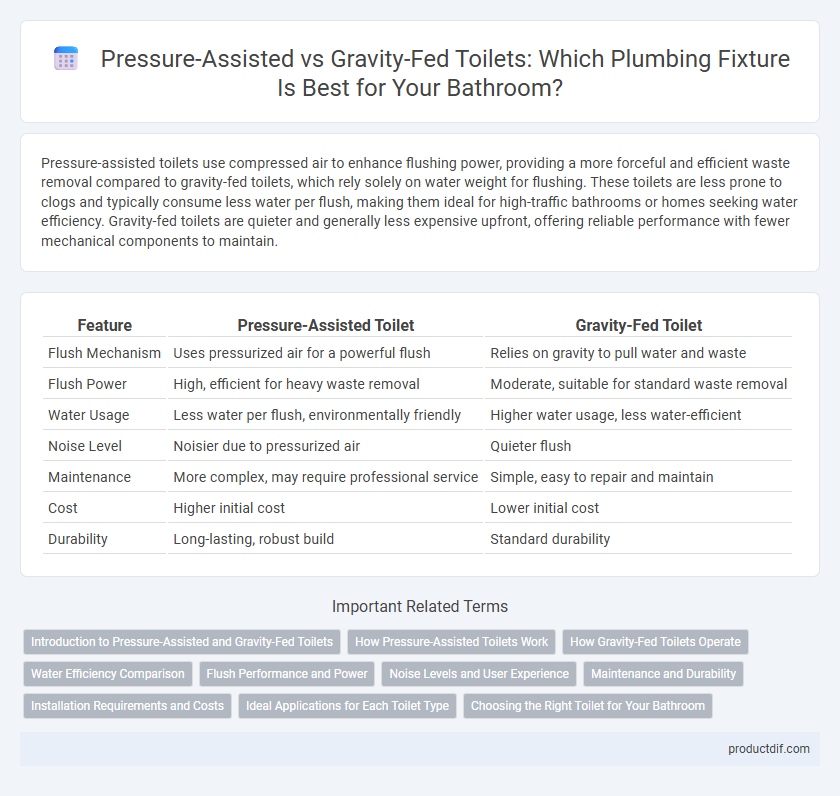Pressure-assisted toilets use compressed air to enhance flushing power, providing a more forceful and efficient waste removal compared to gravity-fed toilets, which rely solely on water weight for flushing. These toilets are less prone to clogs and typically consume less water per flush, making them ideal for high-traffic bathrooms or homes seeking water efficiency. Gravity-fed toilets are quieter and generally less expensive upfront, offering reliable performance with fewer mechanical components to maintain.
Table of Comparison
| Feature | Pressure-Assisted Toilet | Gravity-Fed Toilet |
|---|---|---|
| Flush Mechanism | Uses pressurized air for a powerful flush | Relies on gravity to pull water and waste |
| Flush Power | High, efficient for heavy waste removal | Moderate, suitable for standard waste removal |
| Water Usage | Less water per flush, environmentally friendly | Higher water usage, less water-efficient |
| Noise Level | Noisier due to pressurized air | Quieter flush |
| Maintenance | More complex, may require professional service | Simple, easy to repair and maintain |
| Cost | Higher initial cost | Lower initial cost |
| Durability | Long-lasting, robust build | Standard durability |
Introduction to Pressure-Assisted and Gravity-Fed Toilets
Pressure-assisted toilets utilize compressed air to forcefully expel water, creating a powerful flush that reduces clogs and improves efficiency. Gravity-fed toilets rely on the natural force of gravity to move water from the tank to the bowl, offering a quieter operation and simpler design. Understanding these technologies is key for selecting a plumbing fixture that balances performance and maintenance requirements.
How Pressure-Assisted Toilets Work
Pressure-assisted toilets utilize compressed air within a sealed tank to forcefully propel water into the bowl, creating a powerful flush that reduces clogs and improves efficiency. These systems separate air and water chambers, allowing air pressure to build up and release rapidly when flushed, unlike gravity-fed toilets which rely solely on the weight of the water. This mechanism enhances flushing performance and is especially effective in commercial or high-demand environments.
How Gravity-Fed Toilets Operate
Gravity-fed toilets operate using the force of gravity to flush waste from the bowl by releasing water stored in the tank above. When the flush lever is activated, a flapper valve opens, allowing water to flow down into the toilet bowl, creating a siphoning effect that efficiently removes waste. This simple mechanism relies on no additional pressure systems, making gravity-fed toilets quieter and less prone to mechanical failure compared to pressure-assisted models.
Water Efficiency Comparison
Pressure-assisted toilets deliver a powerful flush using compressed air, often requiring less water per flush compared to gravity-fed toilets, which rely on gravity to initiate flushing. These pressure-assisted models typically use around 1.0 to 1.28 gallons per flush (GPF), whereas traditional gravity-fed toilets average 1.6 GPF, resulting in significant water savings. WaterSense certification frequently highlights pressure-assisted toilets for their superior efficiency in reducing overall household water consumption.
Flush Performance and Power
Pressure-assisted toilets deliver stronger flush performance by utilizing compressed air to amplify water force, resulting in more powerful and efficient waste removal compared to gravity-fed toilets. Gravity-fed models rely solely on water weight, offering quieter but less forceful flushes that may require multiple activations for solid waste clearance. Enhanced pressure-assisted technology reduces clogs and improves overall flushing power, making it ideal for high-usage environments seeking reliability and superior performance.
Noise Levels and User Experience
Pressure-assisted toilets generate louder flushing noises due to the high-pressure air mechanism, which can be disruptive in quiet household environments. Gravity-fed toilets offer a quieter flush by relying on natural water flow, enhancing user comfort and minimizing bathroom noise. Users seeking a balance between efficient flushing and noise control often prefer gravity-fed models for a more pleasant bathroom experience.
Maintenance and Durability
Pressure-assisted toilets feature fewer moving parts prone to wear, resulting in lower maintenance needs and longer durability compared to gravity-fed toilets, which rely on a simpler flush mechanism that can wear out faster. The robust design of pressure-assisted tanks withstands high water pressure, minimizing leaks and corrosion issues common in traditional gravity-fed models. Routine maintenance for pressure-assisted toilets primarily involves inspecting the pressure chamber, while gravity-fed toilets often require more frequent repairs to flappers and seals due to exposure to sediment and wear.
Installation Requirements and Costs
Pressure-assisted toilets demand more robust plumbing connections and may require professional installation due to their complex pressure systems, leading to higher initial installation costs. Gravity-fed toilets use standard plumbing setups, allowing for easier, less expensive installation and compatibility with most residential plumbing. The upfront expense of pressure-assisted models is offset by their efficient flush performance, whereas gravity-fed toilets offer cost-effective installation and maintenance.
Ideal Applications for Each Toilet Type
Pressure-assisted toilets excel in commercial settings, high-traffic restrooms, and homes requiring powerful flushing to prevent clogs, making them ideal for large families or heavy usage environments. Gravity-fed toilets perform best in residential bathrooms with moderate water pressure and offer quieter operation and easier maintenance, suitable for standard household use and water-conscious locations. Selecting the appropriate type depends on water supply characteristics, required flush power, and maintenance preferences.
Choosing the Right Toilet for Your Bathroom
Pressure-assisted toilets deliver a powerful flush by using compressed air to enhance water force, reducing clogs and increasing efficiency, making them ideal for high-traffic bathrooms and commercial settings. Gravity-fed toilets rely on the natural force of gravity to move water from the tank to the bowl, providing a quieter flush with simpler mechanics and often lower initial cost, suitable for residential bathrooms. Selecting the right toilet involves considering bathroom usage, noise preference, maintenance capabilities, and water efficiency standards such as EPA WaterSense certification.
pressure-assisted toilet vs gravity-fed toilet Infographic

 productdif.com
productdif.com